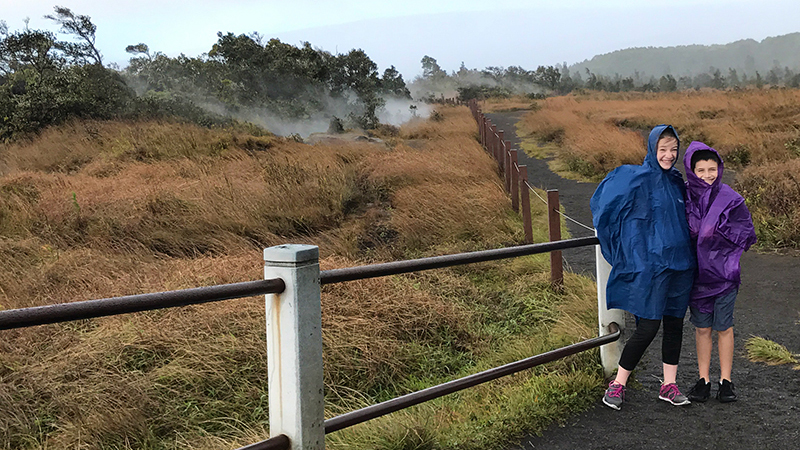
We visited Steaming Bluff and the Steam Vents in the late morning after visiting the Jaggar Museum and the Kīlauea Overlook. It was raining pretty consistently, so while we felt ridiculous, we all were happy to have plastic ponchos to wear. Not only did they keep us dry, they kept us warm too!
When we pulled into the parking area, we were the only people there, which was awesome. Several trails lead from the parking lot to fenced off steam vents releasing large plumes of clean steam into the air.
Steam vents are created by ground water that seeps down to the hot volcanic rocks and returns to the surface as steam.
We took our time following the trails, peeking into the steam vents, braving the crazy wind, and marveling at the fact that in this giant, wide-open area, there are only grasses and small shrubs and no trees. Apparently, the ground a few feet below the surface is so hot that no tree roots can survive.
The walk from the steam vents parking area to Steaming Bluff is 0.25 miles round trip. Steaming Bluff is a series of ground cracks along the edge of Kīlauea Caldera that pour out steam. Here you get a new perspective on the enormous caldera.
Once back at the parking area, we realized that we could see Sulfur Banks Trail and more Steam Vents across the street and decided to leave the car and walk over.
Know Before You Go
- The The Steam Vents Trail is located 0.8 miles from the Jaggar Museum, 1.5 miles from the Kīlauea Overlook, and 0.7 miles from the Kīlauea Visitor Center on Crater Rim Drive in Hawai’i Volcanoes National Park.
- Across the street is the Sulfur Banks Trail, which means you can park in one place for both attractions.
- The steam vents output water vapor and can be very hot. Do not enter a steam vent — it can cause severe burns or death.
- The area is most spectacular in the morning when the air is cool or during rains because the rain water seeps into the ground, which creates large warm steam plumes.
- Please be respectful while visiting this area. It has great cultural significance for many Hawaiian families who come to heal after being sick, to release bad toxins or bad vibes, and to give offerings to Pele.






